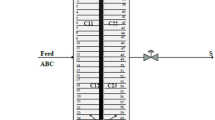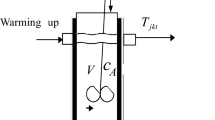Abstract
In this paper, a new technique to determine the best values of a PID controller is presented. The proposed scheme is based on using a single-neuron controller which its weights represent the PID parameters. Weight’s adjustment is accomplished with a recent meta-heuristic algorithm called the DragonFly Algorithm. To show the effectiveness of our method, we have applied it to control a Continuous Stirred Tank Reactor. The obtained results are compared with several algorithms: the Ziegler–Nichols, Genetic Algorithm, and Particle Swarm Optimization.




















Similar content being viewed by others
References
M. Salazar and F. Méndez, PID control for a single-stage transcritical CO2 refrigeration cycle. App. Therm. Eng., 67 (2014) 429–438.
P.V.M. Maalini and G.S. Prabhakar, “Modelling and control of ball and beam system using PID controller”, In Proc. Int. Conf. Adv. Comm. and Comp. Tech., pp. 322–326 (2016).
Vivekananathan et al., “Design and optimization of multivariable controller for CSTR system, in: Robot. Autom. “ Control Embed. Syst. (RACE), Int. Conf., IEEE, pp. 1–5, 2015.
J.G. Ziegler and N.B. Nichols, Optimum settings for automatic controllers. Trans. ASME, 64 (1942) 759–768.
B. Westerberg, B. Wittenmark, K.J. “Åström, Self-tuning PID controllers based on pole placement. Department of Automatic Control”, Lund Institute Technical Report, TFRT-7179 (1979).
M.A. da Silva, F.A.C. Gomide, and W.C. Amaral, “A rule based procedure for self tuning PID controllers”, In Proc. 27th Conf. on decision and control, pp. 1947–1951 (1988).
A. Nayak and M. Singh, Study of tunning of PID controller by using particle swam optimization. Int. J. Adv. Res. Stud., (2015) 346–350.
M.V. Patel and R.M. Pathak, PID tuning using genetic algorithm for DC motor positional control system. Int. J. Innov. Eng. Tech., 6 (2015) 141–147.
M. Li, L. Wang, J. Liu, and J. Ye, “Method study on fuzzy-PID adaptive control of electric-hydraulic hitch system”, In Conf. Proc. Adv. in Materials, Machinery, Electronics, pp. 1–8 (2017).
S. Zuo, Y. Song, L. Wang, and Z. Zhou, “Neuron-adaptive PID based speed control of SCSG wind turbine system”, In Abst. Appl. analysis, pp. 1–10 (2014.
L. Huang, L. Yu, S. Quan, L. Huang, Q. Chen, Y. Xiong, and J. Quan, “Design of voltage loop for three-phase PWM rectifier based on single neuron adaptive PID control”, In 32nd youth academic annual conf. of Chinese association of automation, pp. 171–175 (2016).
N. Kamala, “Studies in modeling and design of controllers for a nonideal continuous stirred tank reactor” Ph.D. dissertation, Dept. Elect. Eng., Anna University, Chennai, April (2011).
S. Baruah and L. Dewan, “A comparative study of PID based temperature control of CSTR using genetic algorithm and particle swarm optimization,” In 2017 international conference on emerging trends in computing and communication technologies (ICETCCT), Dehradun, pp. 1–6 (2017).
P. Deulkar and S. Hanwate, “Analysis of PSO-PID controller for CSTR temperature control”, In IEEE first international conference on smart technologies for power energy and control (STPEC), pp. 1–6 (2020).
M. Ren et al., Single neuron stochastic predictive PID control algorithm for nonlinear and non-Gaussian systems using the survival information potential criterion. Entropy, 18(6) (2016) 232–237.
X. Zan and F. Xie, “Switched reluctance generator system based on single neuron adaptive PID controller”. In Proceedings of the 2011 international conference on advanced mechatronic systems, pp. 123–127 (2011).
S. Mirjalili, Dragonfly algorithm: a new meta-heuristic optimization technique for solving single-objective, discrete, and multi-objective problems. Neural Comput. Appl., 27(4) (2016) 1053–1073.
R.K.S. Sree and S. Murugan, Memory based hybrid dragonfly algorithm for numerical optimization problems. Expert Syst. Appl., 83 (2017) 63–78.
G.M. Viswanathan et al., Lévy flights in random searches. Phys. A Stat. Mech. Appl., 282(1) (2000) 1–12.
X.S. Yang, Nature-inspired metaheuristic algorithms, 2nd edn. Luniver press, Bristol (2010).
Author information
Authors and Affiliations
Corresponding author
Additional information
Publisher's Note
Springer Nature remains neutral with regard to jurisdictional claims in published maps and institutional affiliations.
Rights and permissions
Springer Nature or its licensor (e.g. a society or other partner) holds exclusive rights to this article under a publishing agreement with the author(s) or other rightsholder(s); author self-archiving of the accepted manuscript version of this article is solely governed by the terms of such publishing agreement and applicable law.
About this article
Cite this article
Ladjouzi, S., Grouni, S. A Single-Neuron-Based Temperature Control of a Continuous Stirred Tank Reactor. MAPAN (2024). https://doi.org/10.1007/s12647-024-00749-y
Received:
Accepted:
Published:
DOI: https://doi.org/10.1007/s12647-024-00749-y




